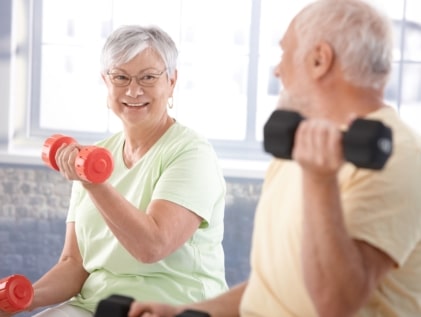When it comes to joint health and flexibility, the adage “if you don’t use it, you lose it” could not be more applicable. As we age, our joint health and flexibility become compromised, and this is especially true for seniors that do not engage in regular exercise and movement activities. Exercising lubricates joints which, in turn, reduces swelling or pain, improves symptoms of arthritis, and promotes better flexibility. Exercising for joint health should involve activities that are low-impact and include components of stretching, balance training, and strength training.
Swimming and Water Aerobics. Even the most inexperienced swimmer can reap the benefits that spending time in the pool has to offer! Exercising in water provides a low-impact cardiovascular workout that simultaneously strengthens the muscles. Swimming or walking laps, enrolling in a water aerobics class, or playing a round of Marco Polo with the grandkids are all great ways to get moving while keeping stress on the joints to a minimum.
Walking. For most, walking is immediately accessible and can be done anywhere. Walking outdoors, around the mall, or even at the gym on a treadmill are excellent choices. Walking is easy on the joints and aids in strengthening the muscles that protect the knee and hip joints. Also, studies have shown that walking may prevent arthritis from forming and can reduce arthritis-related pain. As a bonus, walking is a wonderful way to improve balance.
Tai Chi. Tai Chi is an ancient Chinese tradition that has become a popular form of exercise. It combines a series of slowly executed movements and deep breathing and provides a wide array of benefits. In addition to encouraging joint motion, tai chi is low-impact, helps to alleviate stress and anxiety, and has been shown to lower the risk of falls in the elderly.
Stretching. Working through a series of self-guided stretches is a simple way to promote flexibility and deter the decline of joints. Furthermore, it is important to stretch to maintain joint range of motion and to perform regular activities of daily life. It is recommended that seniors stretch at least two to three times a week, though five times per week is ideal. Static stretching, or holding a stretch for thirty to sixty seconds, is the best option for beginners.
Fitness Classes. As the number of Americans aged sixty-five and older is continuing to increase, the fitness industry has begun catering directly to this demographic. Many classes are taught seated in a chair, and instructors can modify their classes for participants of all levels. Check your local gym, senior center, or library for fitness classes geared toward senior citizens. Silver Sneakers is an excellent resource and even offers on-demand workouts that can be done in the comfort of one’s own home.
As always, be sure to discuss the most appropriate forms of exercise for your senior with a physician. Once you’ve been given the go-ahead, get moving and have fun!


